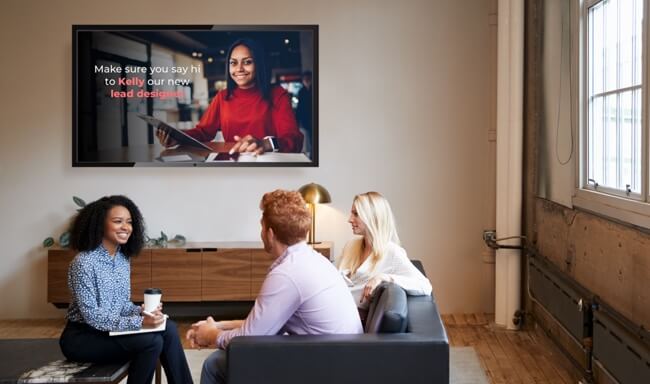
Discover the new and innovative methods businesses are using to engage with their employees
Read any employee review site and you’ll quickly learn that communication a top indicator of satisfaction. The most successful managers communicate with team members effectively in order to maintain productivity and ensure that desired outcomes are being met. Otherwise, employees lose motivation and fail to work towards common goals in a cohesive, cooperative manner, which results in fragmented operations.
But developing HR plans and programs that support your organizational goals while simultaneously keeping employees engaged and motivated is hard. Despite the best intentions, many business leaders find themselves at a loss. They’re frustrated by the results of their current HR communication strategy, and yet remain uncertain about how to change it.
This challenge is largely a result of how rapidly the way people work has changed in recent years. With more and more people working remotely, taking advantage of flexible work hours, and enjoying less structured, more collaborative work environments, there has been a shift in how companies communicate with their employees.

The days of simple, straightforward blast emails informing employees about changes or new developments are gone.
Instead, employees want to be invited to an active, engaging conversation with the companies they work for.
Yet 74 percent of employees still feel they’re missing out on internal information and news in the workplace.
So, what can businesses do to improve their HR communication and generate higher engagement rates?
Here Are Three Emerging HR Communication Trends Every Business Should Be Implementing:
It might seem that there are an endless number of tips and recommendations on how to improve your communications, but what’s really going to be effective? In this blog post, we’ll cut through the noise to focus on three of the most effective options that business leaders are using today.
1. Multi-platform Delivery
It used to be that single platform human resource communication was enough. Employers could communicate effectively with the teams with a single printed newsletter, blast email or even a flyer on a bulletin board, since the majority of their employees spent all day in one location – completing the majority of their tasks from desks.
But the rapid advancement of technology has resulted in a more mobile workforce, with employees now using tablets, laptops, and cell phones to complete projects and conduct their daily tasks while on-the-go.
In fact, 70 percent of professionals now work remotely at least once a week.
Thus, it’s imperative that businesses implement an HR communication plan that takes a diverse approach to delivery.

Some of the ways employers can now deliver HR communications to employees include:
- Mass texting (direct to the cell phones of employees)
- Internal websites
- E-newsletters
- Private group messaging platforms (Think Slack or Yammer)
- Internal questionnaires and surveys
- Digital signage software
- Custom mobile apps
And more.
Ideally, a company should be using more than one method of communication, since employees may or may not check each of these platforms regularly.
2. Investing In Video
Video is by far the fastest-growing form of online content. In fact, videos are predicted to account for more than 80 percent of all consumer internet traffic by the year 2020.
So, why not capitalize on this trend by incorporating it into your HR and communication efforts?

Some ways you can include video in your HR communication to employees include:
- Filming internal employee training videos
- Including links to videos in your internal e-newsletter
- Using video conferencing to interact with employees who are working remotely
- Using screen-capture videos to show employees how to complete a specific computer-related task
- Hosting internal webinars
- Displaying videos on large screens via digital signage software
And more.
Plus, since 41 percent of internal communication professionals say they plan to incorporate more video in their strategies moving forward, there is no better time to begin implementing this powerful content method. And if that doesn’t convince you, just consider the fact that employees are 75 percent more likely to watch a video than to read emails, documents, or web articles.
3. More Personalization
Did you know that 24 percent of employees say they want more personalized HR communications from their employers?
If your HRM communication program doesn’t take this fact into consideration, you could be missing out on opportunities to better align your team members with the mission and vision of your company.
By segmenting your employees and only delivering messages that apply directly to the recipients you select, you enhance the effectiveness of your HR plans and programs.
When employees receive communications that are specific to their role, department, or location, they feel like their employers care about providing information that is relevant and applicable to them.

This is particularly important since 80 percent of employees feel that they experience email overload at work.
By sending personalized communications exclusively to the people who are directly affected, you reduce the amount of time the rest of your team members spend distracted by unnecessary messaging.
Some ways you can personalize your HR communication efforts include:
- Sending an automatic, personalized “Welcome to the Team!” email to new employees
- Sending “Thank You” emails to specific departments when they complete a major project or reach a new milestone
- Highlighting and displaying employee achievements using digital signage software
- Creating internal chat groups for each department and having leadership actively monitor and contribute to group conversations
- Send personalized check-up emails to new employees to make them feel supported and welcomed during the onboarding process
Remember, poor HR communications can cost employers up to $26,041 per employee per year.
In order to protect the profitability and scalability of your business, it’s crucial to embrace and apply these human resource communication trends.